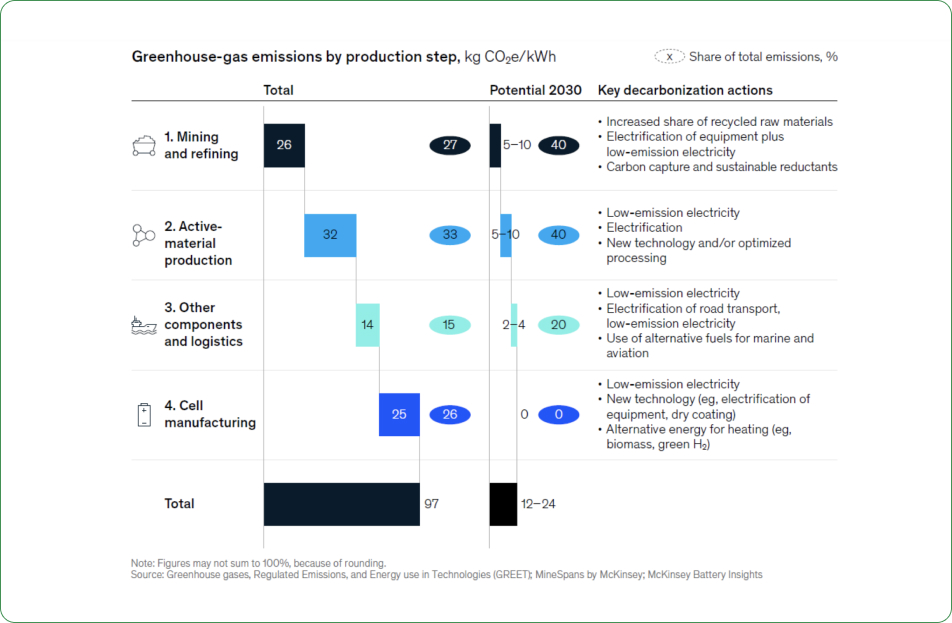11 December 2025


According to ADEME, 30% of total greenhouse gas emissions in France are linked to
transportation. It therefore seems urgent to take concrete action in this sector,
in particular by reducing the use of internal combustion engine vehicles.
Often seen as the primary ecological alternative, the electric vehicle (EV)
is also the subject of much debate. While EVs are considered clean to use,
the production of the vehicle, especially the battery, is highly carbon intensive.
From production plants to applied research, a whole ecosystem is working to propose solutions.
This is the conclusion of a recent study conducted by McKinsey & Company.
Used to power electric vehicles, lithium-ion batteries are responsible for 40 to
60 percent of the total emissions from the production of an EV, according to
calculations by McKinsey & Company. Several factors account for this high carbon footprint: first,
EV batteries contain nickel, manganese, cobalt, lithium and graphite, materials that
emit significant amounts of greenhouse gases (GHGs) during their extraction and refining.
Secondly, the energy required for the chemical and manufacturing processes and for the
transportation of batteries adds a variable portion to the overall carbon footprint.
Depending on the source of energy used
(renewable or fossil), GHG emissions from the manufacturing stages can double!

The McKinsey & Company study shows that within five to seven years,
the carbon footprint of EV battery production could be reduced by an average of 75%.
To achieve this, we need to take sustainable and immediate action across the entire
value chain. The graph below details which decarbonization measures should be taken
as a priority, at each stage of production process.

In addition to these actions, there are other ideas to explore. At a time when upcycling is in vogue, developing recycling solutions for some battery components can also reduce emissions. Today, the carbon footprint of recycled battery materials is on average four times smaller than the one of raw materials from primary sources, again according to data from McKinsey & Company.
Reducing the size of batteries, adopting green mobility solutions for their transportation and seeking more sustainable alternatives to chemical manufacturing processes are other steps recommended by experts in the field to further reduce the carbon footprint of batteries. Regarding the reduction of battery size, there is an urgent need for the automotive industry to align itself with the daily needs of users, in terms of motorized travel.
According to the Federal Highway Administration, 95% of all trips are less than 48km, which is one-sixth the capacity of an EV, based on an average of 300km of range on a full charge. By building smaller and therefore less polluting batteries, equipment manufacturers would be in line with both consumer needs and climate protection objectives!
“Reducing the size of batteries, adopting green mobility solutions for
their transportation and seeking more sustainable alternatives to chemical
manufacturing processes are other steps recommended by experts in the field
to further reduce the carbon footprint of batteries”

So, ideas are coming in to make the production of EV batteries more sustainable. However, implementing them will require that all the players in the value chain work together! Only then it will be possible to build zero-carbon batteries in the medium term. This step would allow the few consumers who are still skeptical about the environmental benefits of EVs to definitively adopt electric mobility!
Read the full McKinsey & Company article.
Source : McKinsey & Company
environ pour recharger jusqu’à 300 km d’autonomie (selon le véhicule)
soit env. 15 euros pour une charge complète, le tarif le plus abordable du marché
environ pour recharger jusqu’à 300 km d’autonomie (selon le véhicule)